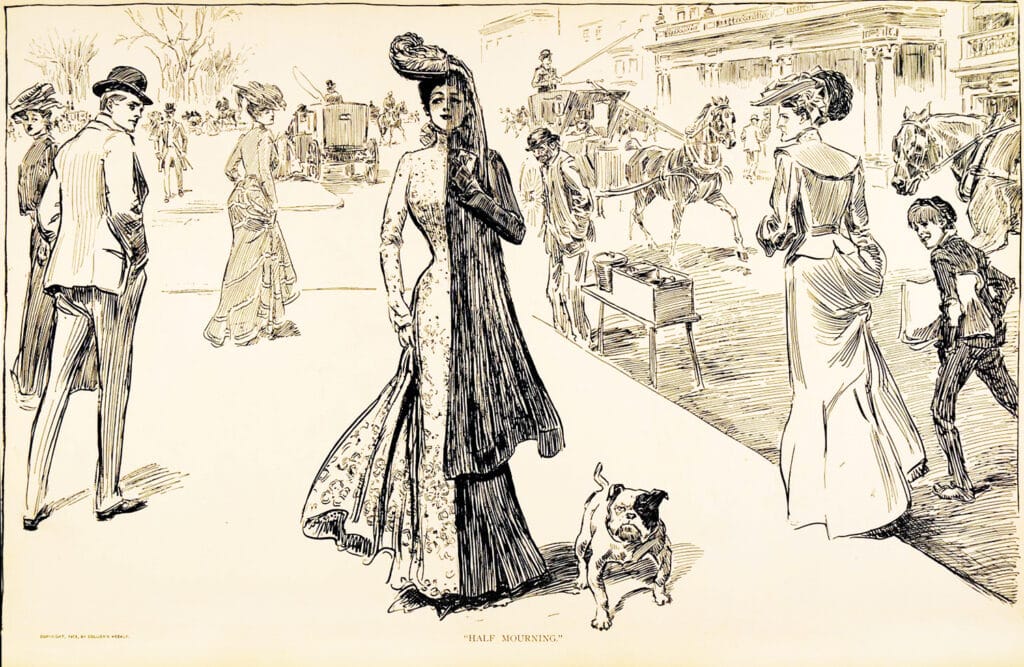Every culture – every religion – every person – mourns in their own way. The sentiment behind that expression, however, is universal: honoring a loved one in a way that publicly displays a depth of loss.
In this issue, we look at the culture of mourning primarily through the lens of the Victorian Era. This nationalistic embrace of ritualistic mourning represented a transition period for mourners in Western societies, democratizing the fashion and rituals of mourning once reserved exclusively for royalty and aristocrats. Today, the remnants of that era – from remembrance jewellery to the accessories in various shades of black that carried men and women through the various stages of mourning – offer collectors, museums, and costume designers rich examples of mourning fashion, each item with its own meaning and associated rules of etiquette.
During the Victorian Era, adhering to the strict and complex set of rules governing the fashion and rituals associated with mourning was a way for one to show off their wealth and refinement. It required a significant investment in time, money, and personal sacrifice, the luxury of which all but the wealthiest of families in England could afford. Those of less than moderate circumstances but rising aspirations often over-extended themselves or worse, lost their home, in an attempt to display their social ascension.
The fashion of Victorian mourning was also embraced by mourners in the U.S. for many of the same reasons its practices caught on in Western Europe.
Old money looked to emulate the complex structure of this aristocratically English model of mourning as a way to maintain some semblance of social order in the face of a rising middle class and industrial wealth (“new money”). Up until the second half of the 19th century, mourning cloth, to be cut and sewn into the garments required for each stage of mourning, and associated goods and accessories, were primarily imported from abroad; however, ‘sudden loss’ from illness, war, or childbirth, a common occurrence up until the 20th century, made this dependence on England both impractical, expensive, and exclusive to all but the wealthy.
The Civil War and its countless losses accelerated the need for a domestic solution to the rigorous and complex requirements of this imported trend. From that demand rose the industrial manufacturing of ready-to-wear mourning garments and mourning warehouses (bereavement department stores modeled off of their English counterparts). Demand also gave rise to the profession of Undertaker, a professional who ‘undertook’ the work traditionally done by a household member of preparing the body for burial, and funeral homes, establishments that could assist mourners in putting on a socially-appropriate funeral. As the mourning market expanded, department stores opened mourning departments and advertised mail order mourning goods through their catalogs, and ladies’ magazines and etiquette handbooks provided mourners guidance in the correct display and presentation of their efforts.
While the color black, prescribed rituals, the establishment of mourning warehouses, and remembrance jewellery played an important role in displayed mourning conventions during the Victorian Era, following Queen Victoria’s death in 1901 we became more internal and individualized in our personal mourning practices as we emerged as a 20th century industrialized nation. One’s religious beliefs and ethnic background became the personal dictates of mourning dress and rituals, and the period for the public display of mourning for a loved one became abbreviated out of necessity and practicality. Yet we also found common ground and national comfort in the adoption of universally-acknowledged symbols of mourning for those we respect as a nation, such as fallen war heroes, political leaders, and treasured citizens.
Memorial quilts, which you will read more about in our October issue have a long association with loss and remembrance. Traditionally a personal expression of mourning in its making and giving to a survivor or for burial with the deceased, in more recent years quilts have taken on more national symbolism. The AIDS Memorial Quilt, begun in 1987, is just one example of how we mourn as a nation and the symbols we universally embrace to show our respects and communicate loss.
The AIDS Quilt was conceived as a national initiative to provide a powerful and colorful reminder of the names and faces behind the statistics. When it was displayed for the first time on October 11, 1987, on the National Mall in Washington, D.C., it covered a space larger than a football field and included 1,920 panels. Today, the AIDS Memorial Quilt is an epic 54-ton tapestry that includes nearly 50,000 panels dedicated to more than 110,000 individuals.
The black armband, first adopted as a sign of mourning in 1770s England, is another. Today, black armbands and ribbons are recognized symbols that signify the wearer is in mourning or wishes to identify with a loss. Floral funeral wreaths are another example. Floral wreaths have been used at funerals since at least the time of Ancient Greece to represent a circle of eternal life. Over time, the flowers and colors used in the making of funeral wreaths took on individual meanings, but the form and function remain basically unchanged. Today, floral wreaths are displayed at memorial services, burial sites, remembrance ceremonies, on top of coffins, and at parades as a symbolic representation of our loss.
The British 17th century tradition of flying the flag at half-mast out of respect for a national loss is another of our more universally recognized symbols of loss in America, its lowering meant to represent the nation’s mourning. According to some sources, the flag is lowered to make room for an “invisible flag of death” flying above. The invisible flag of death is the only flag allowed to fly above the stars and stripes.
Mourning practices, symbols, and public displays will continue to evolve with the times and culture but change does not diminish the depth of one’s loss or the value we place as a nation on showing our respect. The history and evolution of mourning show us that.





Related posts: